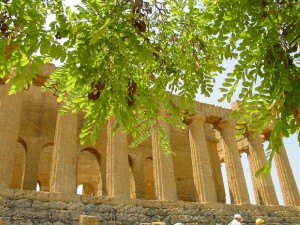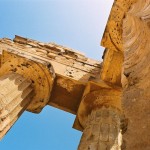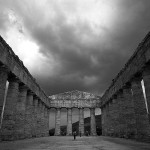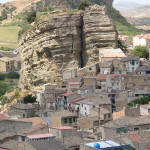
Agrigento has the best preserved Greek temples archaeological park in the world. Agrigento (the ancient Akragas), nowadays world heritage site, was described by Pindar as “the most beautiful city of mortals”. It was founded in 580 b.C. and it kept its glory until 406 b.C., when the Carthaginians besieged and sacked the city and its 200.000 inhabitants. During the roman age Agrigento enjoyed again great importance in the third century b.C. until the final decay caused by the coming of the Byzantines and the Christians, who razed the pagan temples. The area was abandoned and afterwards it was transformed into an archaeological park.
Agrigento has an enormously rich archaeological museum. The landscape of almond trees and the twilight turns Valley of the Temples an idyllic place, although during the tourist season – especially in the rush hour – the steady flow of people can be overwhelming.
During the first week in February the city hosts the International Folklore Festival during the celebrations for the “Almond in blossom” Festival.
Agrigento’s Valley of the Temples
All the Greek temples in Agrigento are in Doric style and it is worth do not missing the opportunity to visit everything, although the conservation status differs according to damage caused by earthquakes and sacks. Temple of Hera (Juno) Lacinia. A large altar for sacrifices precedes the temple of Juno, which rules the top of Valley of the Temples. Dated near 450 b.C., it keeps the row of the northern columns and partly the one of the other three sides. In the roman age it was restored after a fire that ruined a part. You can follow the course toward the Temple of Concordia through a paved path.
This is the best preserved temple and it is 42 meters long and 19,5 meters wide. It was built between 450 and 400 b.C. and its name takes origins from a Latin inscription found on a side. Probably the temple was dedicated to the Dioscuri, Castor and Pollux. It has 34 columns originally white and it keeps the open arches between the columns, since the sixth century it was used as a Christian basilica. Then, in 1749 the temple was restored.
Ahead on the left there is the Villa Aurea, nowadays headquarter of the Management, which has remains of a Byzantine Necropolis with buried tombs, and remains of the Gianbertoni Necropolis with underground tombs from the Hellenistic period. The Temple of Hercules is the most ancient among Agrigento temples and it is dated 510 b.C. It was restored in 1924 and now 8 on 38 original columns stand on their own base. If you deviate temporarily from the path, you will find the tomb of Theron, a first century b.C. funeral monument with squared plan, having a tower with a full doors carved in limestone, and Doric columns on the corners surmounted by Ionic capitals.
Getting back to the pavement you will arrive to the Temple of Olympian Zeus, a huge structure with plant 112,5 meters long and 56 meters wide, which has never been finished. Sizes were smaller only than those of the Temple of Artemis in Ephesus. It owned 17 meters high columns with a diameter of 4,2 meters and it was decorated with 38 telamons, statues of huge dimensions and human appearance, about 8 meters high. In the temple you can see a copy of one of the telamons, while the original is preserved in the museum with a model of the original temple. Unfortunately, in eighteenth century the temple was used as quarry for building jetties in Porto Empedocle.
Behind the Temple of Zeus there is the Temple of Castor and Pollux, which was rebuilt in the nineteenth century with a mixture of elements of other temples. After the construction during the fifth century, this 34 columns temple was severely damaged by the sack of the Carthaginians and later by earthquakes.
At the end of the course there is the Temple of Volcano, which still keeps a basement and two columns. The remains of its rich polychrome clay ornament are preserved in the archaeological museum.
Returning to the modern area of Agrigento, you will find the Archaeological Museum and the San Nicola Church, from which you can enjoy a great sight on the whole Valley of the Temples. Near the church there is a structure carved into the stone, called Ekklesiaterion, where citizens dealt with public debates.
Then, in front of the museum there is the Greek-Roman district, excellently preserved. It shows the ancient city structure with the sewer system, the tanks, the remains of frescoes, the mosaics and the streets, still perfectly defined.





